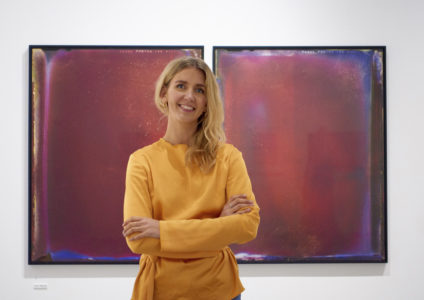Kate Van der Drift has won the 14th Estuary Art and Ecology Award
The 2020 Estuary Art and Ecology Award attracted an unprecedented number of entries.
With almost 100 submissions received during and just after the lockdown period, the quality of the work has been sensational, organisers said.
First prize for the 14th annual award went to a stunning diptych forged through symbiosis of science and art. Aptly named, Van der Drift’s First Quarter Moon to Full Moon was created in the bubble of lockdown and was made, in effect, by the Estuary through the action of water and reaction with its chemical compounds.
Two sheets of large format film were placed and buried deep within the drift and flow of the tides in the sediment near Otahuhu. The pollution and nutrients of surrounding industry and land-use run off mixed with organic matter and micro-organisms, producing vivid alchemical reactions which, when developed, spawned two beautifully unique C-type photographs.
Van der Drift, 34, lives in Ponsonby and grew up in the Waikato and Tauranga. She completed her undergraduate degree in Dunedin majoring in Electronic Arts and then some post graduate studies at Elam School of Fine Arts at the University of Auckland.
“I’ve just started working in the photography department at Elam, looking forward to my first day with the students on Monday as they are returning for second semester then,” she told the Times.

She is delighted with her win. “A great honour given there were so many entries this year, so many interesting and thoughtful works included in the group exhibition of finalists at Uxbridge,” she said.
“This award gave me a good excuse to spend some focused time thinking and learning about the Tamaki Estuary. I’ve been working solely in the Hauraki Plains for the past few years.
“It was great to be able to make some work closer to home with some of the techniques that I’ve developed while making work in and about the damaged waterways of the Hauraki Plains.“
This year’s judge was Head of Visual Arts at the Auckland University of Technology, Monique Jansen. Monique is a committed environmentalist and organic gardener; working on transforming her home and community into a model of resilience, sustainable living, and active citizenship.
Selection of her 25 finalists this year therefore looked closely at the story and methodology behind the Art; calling for an emphasis upon the environmental and protective aspects of the brief.
The award ceremony took place on Saturday July 4. With a first prize of $5000, the awards always receive a notable amount of attention. This year there were many new faces but also some familiar, both artists and guests.
Merit awards, sponsored by Gordon Harris, were announced first and awarded for Confluence a Pen, Ink and Crayon team artwork by Pass the Blue Collaborative. The work was made over two days by six artists and incorporates knowledge of place with knowledge of colonial history and the effects of human activity on the land.
Another merit went to seasoned artist Alan Fletcher who presented A Tidal Shift in Four Movements – Oil on paper – an attempt to capture the tidal shifts as they occurred. Representing this theme of Ebb and Flow in perhaps a more contemporary and yet vintage medium was second prize winner Wesley John Fourie who brought a resurgence of wool craft with his 15.2km interpretation of the Tamaki Estuary.
Over a period of 240 hours, the artist took 15.2 km of materials and finger/arm knit it into a scale model of the estuary itself; the work a shrine to the mighty body of water. His journey to deliver this load of wool was no less a story as he hitched over 100km from the South Island with three binbags of wool.
The Awards will be showcased in the Malcolm Smith Gallery at Uxbridge until the end of August.
Still to be claimed is the People’s Choice Award sponsored by The Rice Family Partnership which carries a further $1000 prize. You can register your own choice for this award – cast your votes at Uxbridge, Tuesday to Saturday until August 28.










